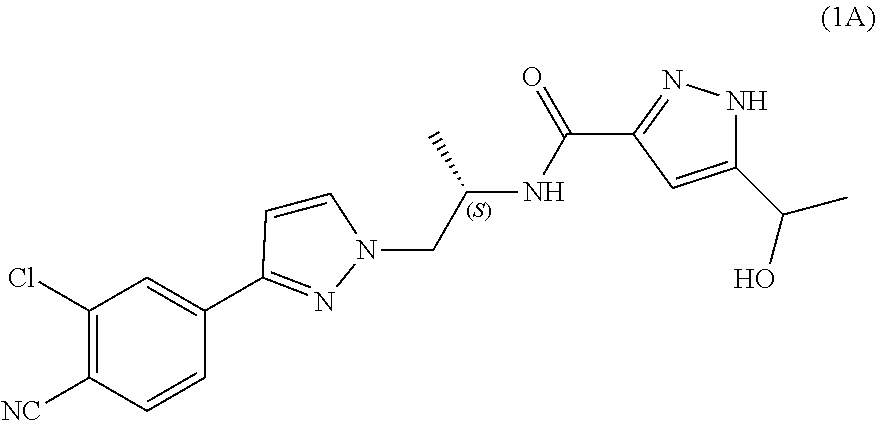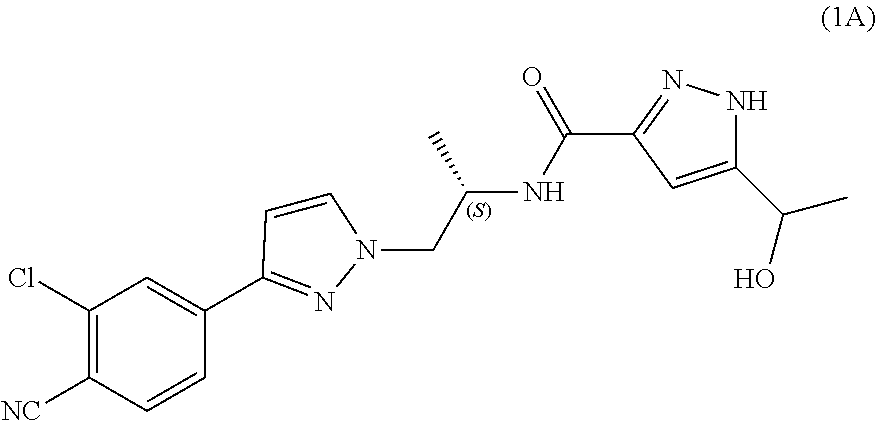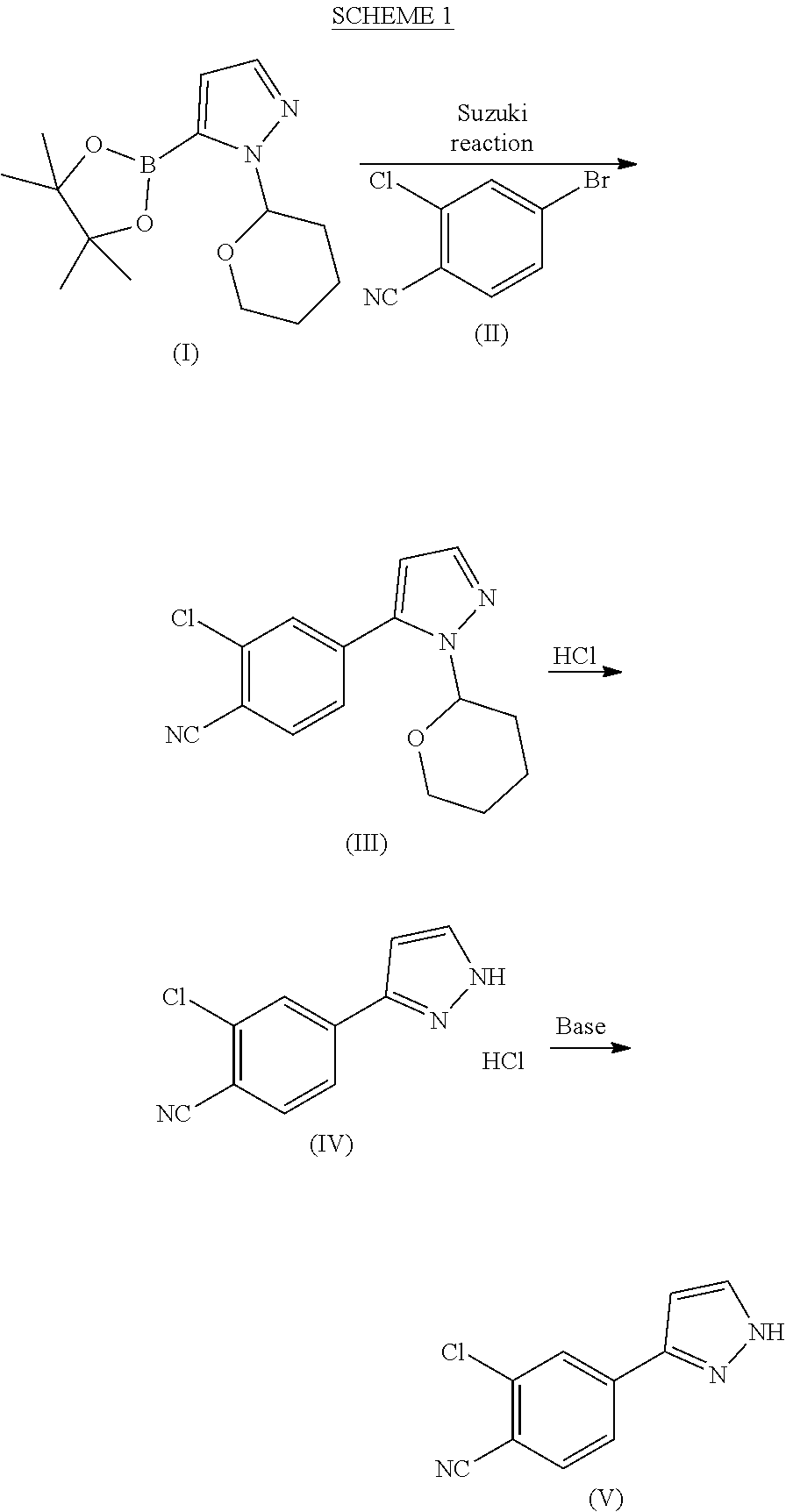Process for the preparation of androgen receptor antagonists and intermediates thereof
- Summary
- Abstract
- Description
- Claims
- Application Information
AI Technical Summary
Benefits of technology
Problems solved by technology
Method used
Image
Examples
example 1
on of 1-(tetrahydro-2H-pyran-2-yl)-5-(4,4,5,5-tetramethyl-1,3,2-dioxaborolan-2-yl)-1H-pyrazole of formula (I)
[0081]1-(Tetrahydro-2H-pyran-2-yl)-1H-pyrazole (5 kg), THF (7.0 l) and toluene (28 l) were mixed at room temperature (RT) under nitrogen atmosphere. The mixture was cooled to 0° C., n-BuLi (17.9 kg, 1.42 M in hexanes) was added dropwise at 0-5° C. over a period of 2-3 h and the mixture was stirred at 0-5° C. for 1 h. Triisopropyl borate (6.8 kg) was added dropwise at 0-5° C. over a period of 45 min. The mixture was brought to RT and stirred for 1-2 h. Pinacol (3.88 kg) was added portion wise to the mixture at RT over a period of 20-30 min followed by stirring for 45 min. The mixture was cooled to 0° C. and acetic acid (3.9 kg) was added dropwise over a period of 30 min at 0-5° C. The mixture was brought to RT and maintained for 12-14 h. The mixture was then cooled to 0° C. and water (20) was added dropwise at 0-5° C. over a period of 30 min. The mixture was brought to RT and ...
example 2
on of 2-chloro-4-(1-(tetrahydro-2H-pyran-2yl)-1H-pyrazol-5-yl)benzonitrile (III)
[0082]Acetonitrile (50 ml), water (50 ml), potassium carbonate*H2O (21.7 g, 2.07 eqv.) and 4-bromo-2-chlorobenzonitrile (II) (14.0 g, 1.00 eqv.) were charged. The mixture was refluxed under nitrogen atmosphere for about 0.5 h. The mixture was cooled to 60-70° C. under nitrogen protection. Palladium(II)acetate Pd(OAc)2 (0.10 g, 0.007 eqv.) and triphenylphosphine (0.40 g, 0024 eqv.) were added under nitrogen protection. 1-(Tetrahydro-2H-pyran-2-yl)-5-(4,4,5,5-tetramethyl-1,3,2-dioxaborolan-2-yl)-1H-pyrazole (I) (21.0 g, 1.17 eqv.) was dissolved in acetonitrile (30 ml). Air was removed by vacuum and replaced by nitrogen. This solution was added to the reaction mixture in about 0.5 h at 70±3° C. The reaction mixture was stirred for 2 h at 70±3° C. The water phase was separated off and removed from the reaction mixture at 65-70° C. 2 ml of ammonia water (25%) was added to the reaction mixture which was then c...
example 3
on of 2-chloro-4-(1H-pyrazol-3-yl)benzonitrile (V)
[0083]2-Chloro-4-(1-(tetrahydro-2H-pyran-2yl)-1H-pyrazol-5-yl)benzonitrile (III) (10.0 g, 1.00 eqv.) and methanol (40 ml) were charged. 30% HCl (0.3 ml, 0.08 eqv.) was added at 10±3° C. The mixture was stirred for 2 h at 10±3° C. Ammonia water (25%) was added (3.0 ml, 1.1 eqv.) at 10±5° C. Water (15 ml) was added gradually at 10-20° C. The mixture was stirred overnight at 20±5° C. The mixture was then cooled to 0-5° C. and stirred for 4 h at 0-5° C. The crystalline product was filtered and washed with cold water:methanol mixture 3:1 (30 ml) and dried at 50-60° C. Yield 6.78 g (95.8%). HPLC-purity 99.7%.
PUM
| Property | Measurement | Unit |
|---|---|---|
| Temperature | aaaaa | aaaaa |
| Temperature | aaaaa | aaaaa |
| Temperature | aaaaa | aaaaa |
Abstract
Description
Claims
Application Information
 Login to View More
Login to View More - R&D
- Intellectual Property
- Life Sciences
- Materials
- Tech Scout
- Unparalleled Data Quality
- Higher Quality Content
- 60% Fewer Hallucinations
Browse by: Latest US Patents, China's latest patents, Technical Efficacy Thesaurus, Application Domain, Technology Topic, Popular Technical Reports.
© 2025 PatSnap. All rights reserved.Legal|Privacy policy|Modern Slavery Act Transparency Statement|Sitemap|About US| Contact US: help@patsnap.com



